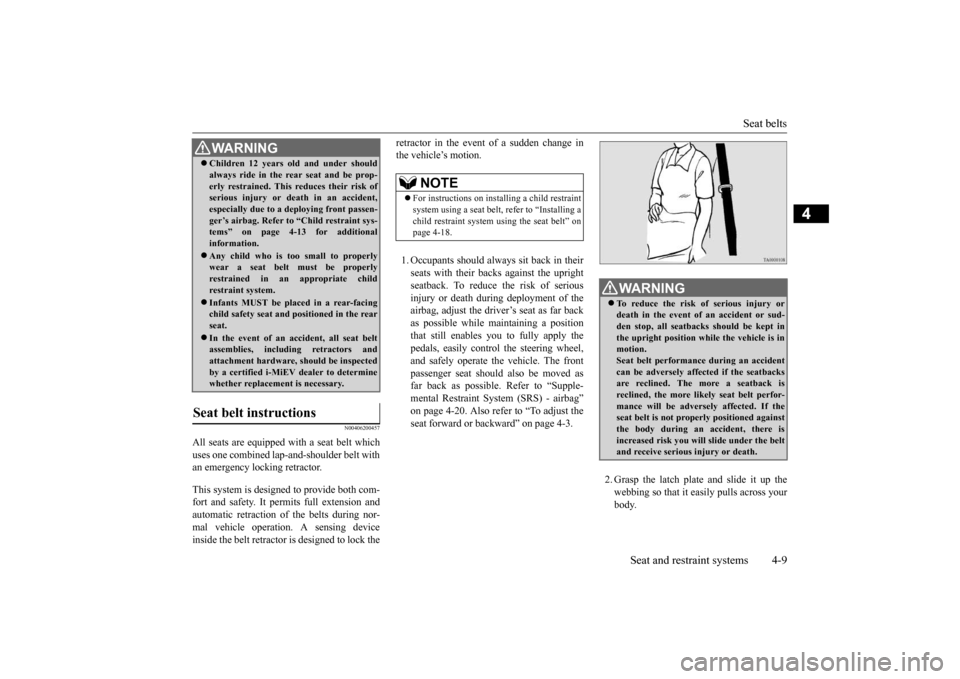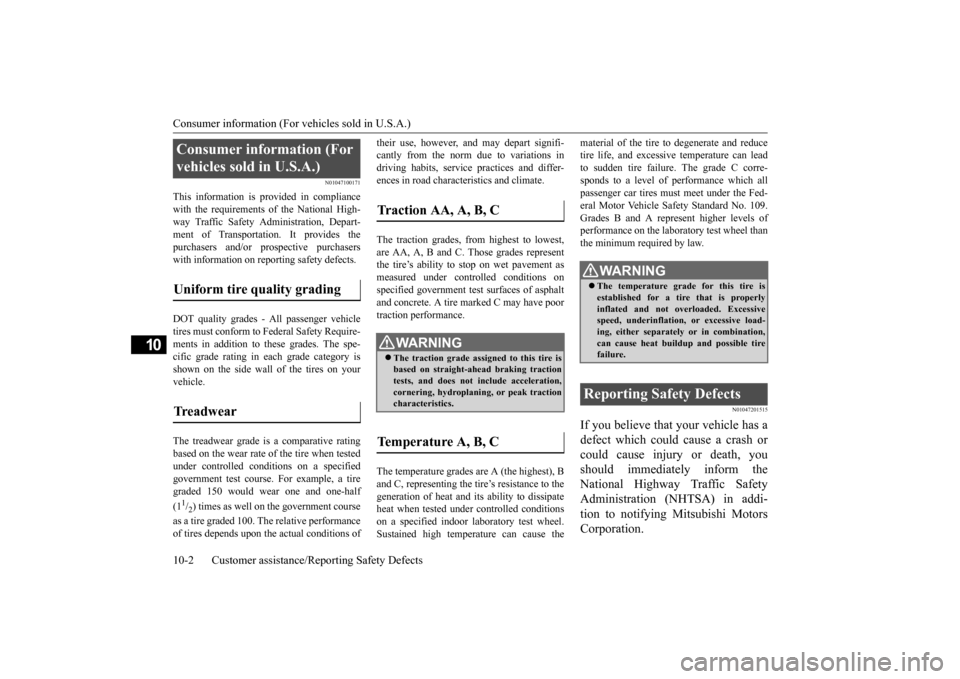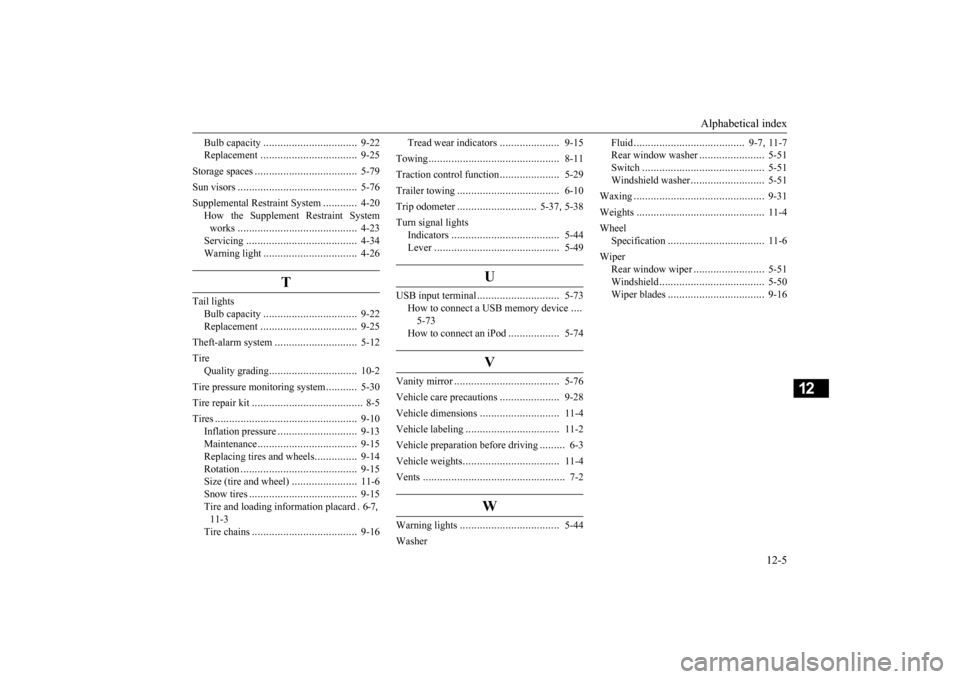2017 MITSUBISHI iMiEV traction control
[x] Cancel search: traction controlPage 81 of 296

Seat belts
Seat and restraint systems 4-9
4
N00406200457
All seats are equipped with a seat belt which uses one combined lap-and-shoulder belt with an emergency locking retractor. This system is designed to provide both com- fort and safety. It perm
its full extension and
automatic retraction of the belts during nor- mal vehicle operation.
A sensing device
inside the belt retractor is designed to lock the
retractor in the event of a sudden change in the vehicle’s motion. 1. Occupants should always
sit back in their
seats with their backs against the upright seatback. To reduce
the risk of serious
injury or death during deployment of theairbag, adjust the driver’s seat as far back as possible while maintaining a position that still enables you to fully apply thepedals, easily control the steering wheel, and safely operate the vehicle. The front passenger seat should also be moved asfar back as possible. Refer to “Supple- mental Restraint System (SRS) - airbag” on page 4-20. Also refer to “To adjust theseat forward or backward” on page 4-3.
2. Grasp the latch plat
e and slide it up the
webbing so that it easily pulls across yourbody.
Children 12 years ol
d and under should
always ride in the re
ar seat and be prop-
erly restrained. This reduces their risk ofserious injury or de
ath in an accident,
especially due to a deploying front passen- ger’s airbag. Refer to
“Child restraint sys-
tems” on page 4-13 for additional information. Any child who is t
oo small to properly
wear a seat belt must be properly restrained in an appropriate childrestraint system. Infants MUST be placed in a rear-facing child safety seat and
positioned in the rear
seat. In the event of an ac
cident, all seat belt
assemblies, including retractors and attachment hardware, should be inspectedby a certified i-MiEV dealer to determine whether replacement is necessary.
Seat belt instructions
WA R N I N G
NOTE
For instructions on installing a child restraint system using a seat belt
, refer to “Installing a
child restraint system using the seat belt” on page 4-18.
WA R N I N G To reduce the risk of serious injury or death in the event of
an accident or sud-
den stop, all seatbacks should be kept in the upright position while the vehicle is inmotion. Seat belt performance during an accident can be adversely affect
ed if the seatbacks
are reclined. The more a seatback is reclined, the more likely seat belt perfor- mance will be advers
ely affected. If the
seat belt is not prop
erly positioned against
the body during an accident, there is increased risk you will slide under the beltand receive serious
injury or death.
BK0220401US.book 9 ページ 2015年6月3日 水曜日 午前7時42分
Page 136 of 296

Active stability control (ASC)
5
N00574400024
If there is a malfunction in the system, the warning light will come on.Under normal conditions
, the warning light
comes on when the electric motor switch is turned to the “ON” position and goes off afew seconds later.
N00559100163
The active stability c
ontrol (ASC) takes over-
all control of the anti-lock braking system, traction control function and skid controlfunction to help maintain the vehicle’s con- trol. Also refer to the following pages on the anti-lock braking system, traction controlfunction and skid control function. Anti-lock braking system (ABS)
P.5-25
Traction control function
P.5-29
Skid control function
P.5-29
WA R N I N GDo not turn the key from the ON position while the vehicle is moving. Stopping theelectric motor unit would make the steer-ing wheel extremely hard to turn, possibly resulting in an accident.NOTE
During repeated full-lock turning of the steering wheel (for example, while you aremaneuvering the vehicle into a parking space), a protection
function may be acti-
vated to prevent overheating of the powersteering system. This f
unction will make the
steering wheel gradually harder to turn. In this event, limit your turning of the steeringwheel for a while. When the system has cooled down, the steering effort will return to normal. If you turn the steering wheel while the vehi- cle is stationary with
the headlights on, the
headlights may become
dim. This behavior
is not abnormal. The headlights will return to their original brightne
ss after a short while.
Electric power steering system warning light
CAUTION If the warning light a
ppears while the elec-
tric motor unit is running, have the vehicle inspected at a certified i-MiEV dealer as soon as possible. It may become harder toturn the steering wheel.
Active stability control (ASC)
CAUTION Do not over-rely on the ASC. Even the ASC cannot prevent the natural laws of physics from acting on the vehicle. This system, like any other system, has li
mits and cannot help
you to maintain traction and control of the vehicle in all circumstances. Reckless driv- ing can lead to accident
s. It is the driver’s
responsibility to drive carefully. This means taking into account the tr
affic, road and envi-
ronmental conditions. Be sure to use the specified type and size of tire on all four wheels
. Otherwise, the ASC
may not work properly. Do not install any aftermarket limited slip differential (LSD) on
your vehicle. The ASC
may stop functioning properly.
BK0220401US.book 28 ページ 2015年6月3日 水曜日 午前7時42分
Page 137 of 296

Active stability control (ASC) Features and controls 5-29
5
N00559200089
On slippery surfaces, the traction control function prevents the drive wheels from spin- ning excessively, thus helping the vehicle to start moving from a stopped condition. It alsoprovides sufficient driving force and steering performance as the vehicle turns while press- ing the acceleration pedal.
N00546800049
The skid control function is designed to help the driver maintain control of the vehicle on slippery roads or during rapid steeringmaneuvers. It works by controlling the elec- tric motor unit output and the brake on each wheel.
N00559401280
The ASC is automatically activated when theelectric motor switch is turned to the “ON”
vate the system by
pressing down the ASC OFF switch for 3 sec-onds or longer. When the ASC is deacti
vated, the indica-
tor will be illuminated. To reactivate the
ASC, momentarily
press the ASC OFF
switch; the indicator is turned off.
NOTE
An operation noise may be emitted from under the hood in the fo
llowing situations.
The sound is associated
with checking the
operations of the ASC.
At this time, you may
feel a shock from the brake pedal if you depress it. These do not indicate a malfunc-tion. • When the electric motor switch is set to the “ON” position. • When the vehicle is driven for a while after the electric motor unit is turned on.
When the ASC is acti
vated, you may feel a
vibration in the vehicle body or hear a whin- ing sound from under the hood. This indicates that the system is operatingnormally. It does not i
ndicate a malfunction.
When the anti-lock braking system warning light is illuminated, the ASC is not active.
Traction control function
CAUTION When driving a vehicle on a snowy or icy road, be sure to install snow tires and drivethe vehicle at moderate speeds.
Skid control function
NOTE
The skid control func
tion operates at speeds
of about 9 mph (15 km/h) or higher.
ASC OFF switch
CAUTION For safety reasons, the ASC OFF switch should be operated when your vehicle isstopped. Be sure to keep the ASC on while driving in normal circumstances. If you deactivate the ASC to move out of mud, sand or fresh snow
, be sure to reacti-
vate the ASC immediately when done. Do not deactivate
the ASC except when neces-
sary. If you depress the accelerator pedal exces- sively and the wheels continue spinning while the ASC is deactivated, the transmis- sion or other parts ma
y become damaged and
could cause an
accident.
BK0220401US.book 29 ページ 2015年6月3日 水曜日 午前7時42分
Page 138 of 296

Tire pressure monitoring system 5-30 Features and controls
5
N00546901063
The indicators should illuminate when the electric motor switch is turned to the “ON”
off after a few sec-
onds. If the indicator stays on
or does not illuminate
when the electric motor switch is turned to the “ON” position, have the vehicle inspected by a certified i-MiEV de
aler as soon as possi-
ble.
indicator blinks when the ASC is operat- ing. indicator is illuminated when the ASC is deactivated.
N00530201537
The tire pressure moni
toring system uses tire
inflation pressure sensors (A) on the wheels to monitor the tire inflation pressures. Thesystem only indicates wh
en a tire is signifi-
cantly under-inflated.
NOTE
Using the ASC OFF switch turns off both the skid control function a
nd the traction control
function. When trying to move out of mud, sand or fresh snow, even if the accelerator pedal isdepressed, the ASC ma
y not allow the elec-
tric motor speed to increase enough to move the vehicle out.In such situations, de
activating the ASC may
make it easier to
move your vehicle out.
Refer to “If your vehi
cle becomes stuck in
sand, mud or snow” on page 8-13. If you continue to press the ASC OFF switch after the ASC has been turned off, the ASC will automatically be reactivated to prevent misoperation of th
e ASC OFF switch.
ASC indicator, ASC OFF indi- cator
CAUTION When indicator blinks, the ASC is oper- ating, which means that the road is slippery or that your vehicle’
s wheels are beginning
to slip. If this happens, drive slower. If an abnormal condition occurs in the sys- tem while driving, the and indicators will illuminate. In these cases, follow these procedures:• Park your vehicle in
a safe place and stop
the electric motor unit. Restart the electric motor unit again and check whether the and indicators go out
. If these indicators
go out, there is no abnormal condition. If the and indicators remain on even after your vehicle is driven a short distance after re-starting the electric motor unit, have the vehicle inspected by a certified i-MiEV dealer as soon as possible.
When towing the vehicle with only the rear wheels raised off the ground, do not place the electric motor switch in the “ON” posi- tion. Placing the electric motor switch in the“ON” position could ca
use the ASC to oper-
ate, resulting in an accident. For details, refer to
“Towing” on page 8-11.
Tire pressure monitoring system
NOTE
The tire pressure monitoring system is not a substitute for regularly
checking tire infla-
tion pressures. Be sure to check the tire inflation pressures as described in “Tires” on page 9-10.
BK0220401US.book 30 ページ 2015年6月3日 水曜日 午前7時42分
Page 259 of 296

Tires
Vehicle care and maintenance 9-13
9
code may only be on one side. Look for the TIN on the outboard side of tires as mounted on the vehicle. If the TIN is not found on the outboard sidethen you will find it on the inboard side of the tire. EXAMPLE: DOT MA L9 ABCD 1504
The treadwear grade is a comparative rating based on the wear rate of the tire when testedunder controlled conditions on a specified government test course
. For example, a tire
graded 150 would wear one and one-half (11/2) times as well on the government course
as a tire graded 100. The relative performance of tires depends upon the actual conditions of their use, however, and may depart signifi-cantly from the norm due to variations in driving habits, service practices and differ- ences in road characteristics and climate. The traction grades, from highest to lowest, are AA, A, B and C. Those grades represent the tire’s ability to stop on wet pavement as measured under contro
lled conditions on
specified government te
st surfaces of asphalt
and concrete. A tire marked C may have poor traction performance. The temperature grades are A (the highest), B and C, representing the ti
re’s resistance to the
generation of heat and it
s ability to dissipate
heat when tested u
nder controlled conditions
on a specified indoor
laboratory test wheel.
Sustained high temperature can cause the material of the tire to
degenerate and reduce
tire life, and excessive temperature can lead to sudden tire failure. The grade C corre-sponds to a level of
performance which all
passenger car tires must
meet under the Fed-
eral Motor Vehicle Safety Standard No. 109.Grades B and A represent higher levels of performance on the laboratory test wheel than the minimum required by law.
N00939300873
Proper tire inflation pre
ssure is essential for
the safe and satisfac
tory operation of your
vehicle. The wrong tire pressure will cause problems in three major areas: Safety
DOT
Department of Transporta- tion This symbol certifies that the tire is in compliance with the U.S.
Department
of Transportation tire safety standards, and is approved for highway use.
MA
Code representing the tire manufacturing location. (2 digits)
L9 ABCD
Code representing the tire size. (2 digits)Code used by tire manufac- turer. (1 to 4 digits)
15
Number representing the week in which the tire was manufactured. (2 digits)
04
Number representing the year in which the tire was manufactured. (2 digits)
ature Grades Treadwear Tr a c t i o n
TemperatureTire inflation pressures
BK0220401US.book 13 ページ 2015年6月3日 水曜日 午前7時42分
Page 280 of 296

Consumer information (For vehicles sold in U.S.A.) 10-2 Customer assistance/Re
porting Safety Defects
10
N01047100171
This information is provided in compliance with the requirements of the National High- way Traffic Safety Ad
ministration, Depart-
ment of Transportation. It provides the purchasers and/or prospective purchasers with information on repor
ting safety defects.
DOT quality grades - Al
l passenger vehicle
tires must conform to
Federal Safety Require-
ments in addition to these grades. The spe- cific grade rating in each grade category isshown on the side wall of the tires on your vehicle. The treadwear grade is a comparative rating based on the wear rate of
the tire when tested
under controlled conditions on a specifiedgovernment test course
. For example, a tire
graded 150 would wear one and one-half (11/2) times as well on the government course
as a tire graded 100.
The relative performance
of tires depends upon the actual conditions of
their use, however, and may depart signifi- cantly from the norm due to variations indriving habits, service practices and differ- ences in road characteristics and climate. The traction grades, from highest to lowest, are AA, A, B and C. Those grades represent the tire’s ability to
stop on wet pavement as
measured under controlled conditions on specified government te
st surfaces of asphalt
and concrete. A tire marked C may have poor traction performance. The temperature grades are A (the highest), B and C, representing the ti
re’s resistance to the
generation of heat and it
s ability to dissipate
heat when tested un
der controlled conditions
on a specified indoor
laboratory test wheel.
Sustained high temperature can cause the
material of the tire to
degenerate and reduce
tire life, and excessive temperature can leadto sudden tire failure. The grade C corre- sponds to a level of performance which all passenger car tires must meet under the Fed-eral Motor Vehicle Safety Standard No. 109. Grades B and A represent higher levels of performance on the labora
tory test wheel than
the minimum required by law.
N01047201515
If you believe that your vehicle has a defect which could cause a crash or could cause injury or death, you should immediately inform theNational Highway Traffic Safety Administration (NHTSA) in addi- tion to notifying Mitsubishi MotorsCorporation.
Consumer information (For vehicles sold in U.S.A.) Uniform tire quality grading Treadwear
Traction AA, A, B, C
WA R N I N G The traction grade assi
gned to this tire is
based on straight-ahead braking tractiontests, and does not include acceleration, cornering, hydroplani
ng, or peak traction
characteristics.
Temperature A, B, C
WA R N I N G The temperature grade for this tire is established for a tire that is properlyinflated and not overloaded. Excessive speed, underinflation
, or excessive load-
ing, either separately
or in combination,
can cause heat buildup and possible tire failure.
Reporting Safety Defects
BK0220401US.book 2 ページ 2015年6月3日 水曜日 午前7時42分
Page 291 of 296

Alphabetical index
12-1
12
Numerics
12V power outlet
................................
5-76
12V starter battery
................................
9-7
Specification
..................................
11-6
12V starter battery charging system warning light
.................................................
5-45
A
Accessory (installation)
.........................
3-7
Acoustic vehicle alerting system (AVAS)
....
5-23 Active stability control
........................
5-28
ASC indicator
.................................
5-30
ASC OFF indicator
.........................
5-30
ASC OFF switch
............................
5-29
Skid control function
.......................
5-29
Traction control function
.................
5-29
Air conditioning
...................................
7-4
Important air condi
tioning operating tips
..
7-10
Air purifier
.........................................
7-11
Aluminum wheels
...............................
9-32
Antenna
.............................................
7-27
Anti-lock braking system
.....................
5-25
Warning light
........................
5-26
, 5-27
ASC
..................................................
5-28
ASC indicator
.....................................
5-30
ASC OFF indicator
.............................
5-30
ASC OFF switch
................................
5-29
Assist grip
.........................................
5-81
Audio
AM/FM electronicall
y tuned radio with
CD player
....................................
7-11
Error codes
....................................
7-24
Handling of compact discs
..............
7-25
Steering wheel audio re
mote control switch
7-22
B
Back up lights
Bulb capacity
.................................
9-22
Replacement
..................................
9-25
Ball joint, steering li
nkage seals and drive
shaft boots
.......................................
9-17
Battery
12V starter battery charging system warn- ing light
.......................................
5-45
Disconnection and connection
...........
9-9
During cold weather
.........................
9-9
Main drive lithium-ion battery
...........
3-3
Bluetooth® 2.0 interface
.....................
5-53
Brake
Anti-lock braking system
................
5-25
Braking
...........................................
6-5
Fluid
.......................................
9-7
, 11-7
Hose
.............................................
9-17
Parking brake
.................................
5-16
Parking brake lever stroke
...............
9-16
Pedal
.............................................
5-24
Pedal free play
................................
9-16
Power brakes
..................................
5-24
Service brake
..................................
5-24
Warning light
.................................
5-44
Brake assist system
.............................
5-25
Break-in recommendations
....................
5-2
Bulb capacity
......................................
9-22
C
California Perchl
orate Materials
Requirements
.....................................
3-8
Capacities
..........................................
11-7
Card holder
...............................
5-76
, 5-80
Cargo loads
........................................
6-10
Certification label
...............................
11-3
Charging
Quick charging
...............................
3-27
Regular charging
...................
3-16
, 3-26
Charging indicator
..............................
5-44
Charging Timer
..................................
3-41
Charging troubleshooting guide
............
3-31
Chassis number
...................................
11-2
Child restraint
.....................................
4-13
Child safety locks for rear door
............
5-10
Cleaning
BK0220401US.book 1 ページ 2015年6月3日 水曜日 午前7時42分
Page 295 of 296

Alphabetical index
12-5
12
Bulb capacity
.................................
9-22
Replacement
..................................
9-25
Storage spaces
....................................
5-79
Sun visors
..........................................
5-76
Supplemental Re
straint System
............
4-20
How the Supplement Restraint System works
..........................................
4-23
Servicing
.......................................
4-34
Warning light
.................................
4-26
T
Tail lights
Bulb capacity
.................................
9-22
Replacement
..................................
9-25
Theft-alarm system
.............................
5-12
Tire
Quality grading
...............................
10-2
Tire pressure monitoring system
...........
5-30
Tire repair kit
.......................................
8-5
Tires
..................................................
9-10
Inflation pressure
............................
9-13
Maintenance
...................................
9-15
Replacing tires and wheels
...............
9-14
Rotation
.........................................
9-15
Size (tire and wheel)
.......................
11-6
Snow tires
......................................
9-15
Tire and loading information placard
.6-7
,
11-3 Tire chains
.....................................
9-16
Tread wear indicators
.....................
9-15
Towing
..............................................
8-11
Traction control function
.....................
5-29
Trailer towing
....................................
6-10
Trip odometer
............................
5-37
, 5-38
Turn signal lights
Indicators
......................................
5-44
Lever
............................................
5-49
U
USB input terminal
.............................
5-73
How to connect a USB memory device
....
5-73 How to connect an iPod
..................
5-74
V
Vanity mirror
.....................................
5-76
Vehicle care precautions
.....................
9-28
Vehicle dimensions
............................
11-4
Vehicle labeling
.................................
11-2
Vehicle preparation before driving
.........
6-3
Vehicle weights
..................................
11-4
Vents
..................................................
7-2
W
Warning lights
...................................
5-44
Washer
Fluid
.......................................
9-7
, 11-7
Rear window washer
.......................
5-51
Switch
...........................................
5-51
Windshield washer
..........................
5-51
Waxing
..............................................
9-31
Weights
.............................................
11-4
Wheel
Specification
..................................
11-6
Wiper
Rear window wiper
.........................
5-51
Windshield
.....................................
5-50
Wiper blades
..................................
9-16
BK0220401US.book 5 ページ 2015年6月3日 水曜日 午前7時42分